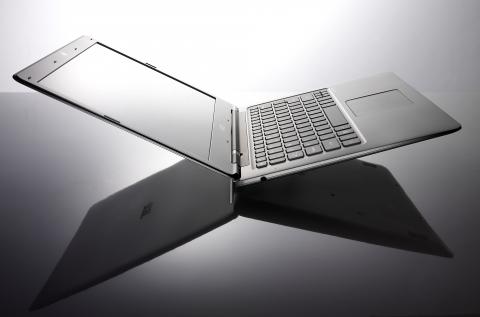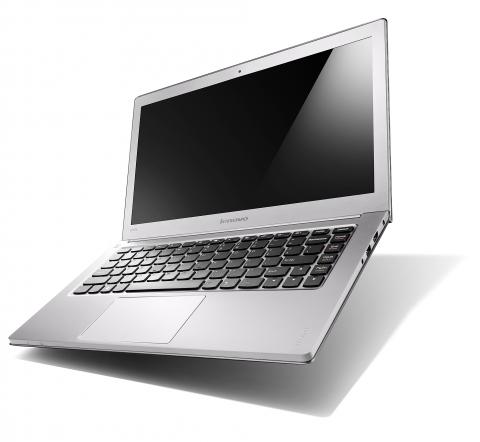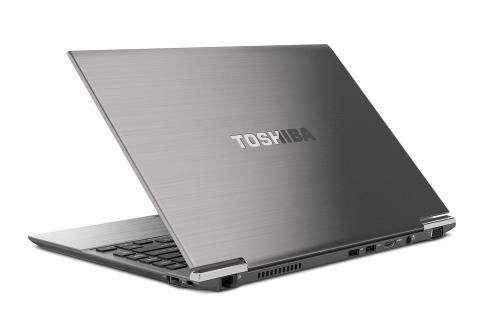If you’ve been wishing for a laptop that has the sleek and svelte look of the Macbook Air but comes with Microsoft Windows installed, the time has come.
The major PC manufacturers have just started to roll out a new set of portable computers that are fast, stylish and super lightweight.
Dubbed “ultrabooks,” which was originally a marketing term coined by Intel, the company that provides the processor chips that power these devices, these new laptops aim for a piece of Apple’s pie.

Photo courtesy of Acer
Like the Air, ultrabooks offer speedy performance and good battery life, not to mention stylish, minimalist designs that feature thin profiles and built-in,
non-replaceable batteries. To achieve their slender measurements, ultrabooks do away with DVD drives.
Models like Asus’ Zenbook (reviewed on page 16 of the Dec. 27, 2011, edition of the Taipei Times) offer an attractive alternative to the Macbook Air. But there are other contenders, too. Here the Taipei Times takes a look at 13-inch-screen ultrabook models from Acer (宏碁), Lenovo and Toshiba.

Photo courtesy of Lenovo
ACER ASPIRE S3: PRAGMATIC YET STYLISH
While Asustek Computer Inc (華碩電腦) tried to outdo Apple by infusing its Zenbooks with industrial design pizzazz, its fellow Taiwanese company Acer took a more pragmatic route with the Aspire S3.
With its brushed metal lid and tapered body, this 13-inch, 1.35kg model also emulates the Macbook Air’s look. The S3’s underside and keyboard chassis are made of plastic, but this isn’t necessarily a bad thing. It might not have the fine craftsmanship feel of the Zenbook or the Macbook Air, but the S3 is solid and sturdy. It doesn’t bend or flex when you rest your hands on the chassis area in front of the keyboard.

Photo courtesy of Toshiba
With its lowest-spec model priced at NT$34,900, the S3 is one of the cheaper ultrabooks around. But the low price means, however, that Acer had to cut a few corners. The S3 doesn’t have some of the newest features, such as a faster USB 3.0 port, and makes compromises when it comes to storage options.
Most ultrabooks are equipped with flash memory, also known as solid-state drives (SSD), which read and record data much faster than the traditional mechanical hard drive.
Acer went with the latter, loading the S3 with a 320 gigabyte hard disk. Although you get more storage space, you’re also left with slightly poorer performance because of the slower speed at which the hard drive writes data. Some programs on the S3 take a few seconds more to load in comparison to other ultrabooks with flash memory drives. Copying large files is also slower.
And because of the mechanical hard drive, the S3 takes more time to power on. The model Acer loaned to the Taipei Times took 48 seconds to boot, whereas most of the other ultrabooks we reviewed, which all have solid state drives, took less than half that time.
But overall, the S3 still runs faster than older laptops, thanks in part to its i5 Intel processor. You will experience few lags if you’re watching videos, using a word processor or listening to music.
And Acer has a trick up its sleeve to make the S3 speedy when waking it from sleep mode. The S3 actually does have a 20 gigabyte SSD, but it can’t be accessed by users. Its sole function is to save memory when you close the lid without shutting down your computer. This allows the S3 to resume full functionality within 3 seconds after opening the lid, a feature dubbed “Instant On.”
Instant On generally worked well for me, but would flake out occasionally. The screen would remain blank after I lifted the lid, leaving me to press the power button to get things going again.
The S3 is a mixed experience when it comes to ergonomics. The keyboard, which has the standard chiclet buttons, was comfortable to type on, although you will have to get used to a few oddities such as a shrunken “Enter” key.
On the other hand, the S3’s trackpad, as with most of the ultrabooks I tested, was frustrating. While typing, my hand often brushed the overly sensitive trackpad, which sent the cursor flying off to another part of the page. This made typing a laborious battle and interrupted my overall workflow. E-mails that should have taken three minutes to write took 10 minutes because I kept having to move the cursor.
The S3’s multi-touch functions on the trackpad are hit and miss. I liked how you could hide all windows by swiping up with four fingers, but two-finger scrolling was often choppy and unresponsive.
Of the four ultrabooks I tested over the past month, the S3 had the least impressive screen. Everything on the 1366-pixel-by-768-pixel display had a strong blue tint, which takes some getting used to. One nice aspect of the screen’s design, though, is that it folds all the way back so the computer can be made nearly flat.
Ultrabooks are being touted for better battery performance, and the S3 does a respectable job. I managed just under 4.5 hours doing routine tasks, which included writing parts of this review, surfing the Web and streaming YouTube videos.
The S3 comes with 4GB (gigabytes) of RAM memory, the current de facto standard among ultrabooks, which helps with the overall speed of the computer, and an SD card slot, which makes it easy to load photos from your camera.
LENOVO IDEAPAD U300S: THINKING DIFFERENT
While Acer and Asus tried to mimic the Macbook Air, Lenovo sought to forge a style of its own with the IdeaPad U300s, which retails for NT$39,900.
On the outside, the U300s sports a classic look, with one particularly nice design detail. The dark gray lid and bottom of the case stretch out beyond the edges of the computer, like the cover of a hardback book.
Though the U300s’ outer casing isn’t outfitted with razor-thin, tapered edges, Lenovo couldn’t quite escape Apple’s shadow with this design. Open the computer, and the U300s looks a lot like the Macbook Air, with its silver unibody casing and black chiclet keys.
The U300s, which weighs 1.39kg, packs the standard ultrabook specs: an Intel Core i5 chip, 4GB of RAM and a 128GB solid state drive. As an ultrabook should, it boots up in 20 seconds and resumes full functionality just several seconds after waking from sleep mode.
In terms of battery life, the Lenovo ultrabook edged out both Acer’s and Asus’ laptops. I got exactly five hours of use out of it, which included normal tasks, such as using a word processor, checking e-mail, surfing the Internet and streaming videos.
In terms of ergonomics, the U300s fared slightly better than the Acer and Asus ultrabooks.
Lenovo has a reputation for making the best keyboards in the business, which are found in its beloved ThinkPad line of laptops. The company applied its know-how to the U300s’ keyboard, but the results are mixed.
The chiclet keys, which feel very nice on the fingertips, have a slight curve, but they don’t quite capture the natural feel of ThinkPad keys. I also found it hard to get used to a few oddly placed keys. The “Page Down,” “Page Up,” “Home” and “End” keys run vertically along the right side of the keyboard, and I often pressed these accidentally when I meant to hit the “Backspace” and “Enter” keys.
As with Asus’ and Acer’s ultrabooks, the U300s’ trackpad was uncooperative. Don’t be swept away by the slick look of the U300s’ spacious, one-button glass trackpad. By default, it’s too sensitive, and I experienced similar problems with the Asus and Acer ultrabooks. Whenever my hand glided over the trackpad while typing, the cursor often flew off across the screen.
You can adjust the responsiveness of the trackpad by playing around with the software settings, but I didn’t have much success. It was hard to get it just right — either the trackpad would be too sensitive or too unresponsive. As for multi-touch gestures, I found two-finger scrolling to be unusable, as it was jerky, and the pinch-to-zoom feature didn’t work on occasion. Hopefully Lenovo and Acer, and Asus for that matter, can solve these problems by tweaking the trackpad software.
The U300s’ picture quality is decent. The 1366-pixel-by-768-pixel screen is bright and clear, and well suited for watching videos full screen.
One concern I had, though, was build quality. While the keyboard chassis feels solid, the display lid on my review unit did not inspire as much confidence. I could hear creaks when opening and closing the computer, which sounded like stressed, fragile plastic. When adjusting the viewing angle, I could feel the lid flex and bend, which caused ripples to appear in the screen.
(As it turns out, my review unit had a defective screen and had to be returned to Lenovo earlier than planned. Lenovo was still investigating the problem as of press time. A company representative told me that the defect was most likely an isolated incident and that other users have not reported similar problems.)
Lenovo’s ultrabook does better than its competitors when it comes to its built-in Web camera, which produces a clearer picture than that of the Asus and Acer ultrabooks. But here’s a head-scratcher: The U300s has no SD card slot, which is an inconvenience if you want to quickly transfer photos or video. This is a strange omission, especially since all of the other 13-inch ultrabook models have managed to fit one in. The U300s does have a USB 3.0 port, though.
Lenovo offers two color choices for the U300s: an orange lid with a black keyboard and interior (which is currently not available in Taiwan) and a charcoal gray lid with silver interior and black keyboard.
TOSHIBA Z830: IT JUST WORKS
There’s relatively less to say about Toshiba’s Portege Z830 because, to borrow a popular phrase from Apple fans, “it just works.”
Toshiba’s ultrabook is perhaps the least stylish — its dark gray shell and non-aerodynamic shape feels like a throwback to the 1990s — but when it comes to user-friendliness, the Z830 is state of the art.
The Z830 shines for its ergonomics. Using the trackpad was a smooth experience: The cursor didn’t randomly jump all over the page, and the multi-touch features worked well. Two-finger scrolling was responsive. Though not quite as smooth as a Mac, the feature came in handy when surfing the Web.
The keyboard has smaller than average chiclet keys, but they are well spaced and the layout feels natural. I got used to it right away, and made very few typing mistakes in comparison to all of the other ultrabooks I’ve used.
Compared to the Asus Zenbook and the Lenovo U300s’ boot-up times of around 20 seconds, the Z830 has a relatively slower start-up time — my review unit booted Windows 7 Ultimate in 28 seconds. In terms
of battery life, the Z830 clocked in at five hours plus a few minutes.
But the most significant number to look at is weight. At 1.2kg, the Z830 is the lightest ultrabook of the bunch I tested, and even makes the 1.35kg, 13-inch Macbook Air feel a tad heavy.
The Z830’s chassis has a bit of flex and feels somewhat flimsy, but Toshiba tries to assure us of its durability in the product literature, which says that underneath the Z830’s casing lies a “honeycomb rib structure” designed to make the computer shock-resistant. The keyboard is also supposed be spill-proof (I didn’t test this feature, though) and is backlit for those who like to type in the dark.
The Z830, which costs NT$43,800 for the standard model, is relatively pricey, considering the specs. It has the standard 1366-pixel-by-768-pixel display, a 128GB SSD, an Intel Core i5 chip and a USB 3.0 port, among other features, but only 2GB of RAM, which may slow down performance (my review unit had 4GB of RAM).
There are two other options, including a cheaper model for NT$31,800, which is equipped with a slower Intel Core i3 chip and does not include a backlit keyboard (these are only available in limited supplies in Taiwan, according to Toshiba), or a more expensive model for NT$45,800, which includes the Intel i5 chip and comes with Windows 7 Professional installed.
A CLEAR-CUT CHOICE?
While none of these ultrabooks knock out the Macbook Air, they generally represent a step up for portable computers. All of these models are lightweight and have good battery life — good enough that if you’re out for the afternoon, you can leave your charger at home without worrying. Ultrabooks generally run cooler than older models, so won’t burn your lap, and, best of all, they are fast when it comes to basic computing tasks, whether it’s using a Web browser, a word processor, or watching a video, or doing all of the above at the same time.
The most user-friendly and smooth-running ultrabook of the bunch is the Toshiba Portege Z830, mainly because of its trouble-free trackpad and keyboard. The Z830 is lightweight even for an ultrabook, which is something to consider if you think the Macbook Air is too heavy.
That said, it’s easy to be wowed by the industrial beauty of Asus’ Zenbooks, which must be appreciated in person. With its relatively low price and higher capacity storage space, Acer’s Aspire S3 appeals to both a sense of style and practicality. Lenovo’s U300s will undoubtedly win some users over for its excellent keyboard.
But laptops are very much a matter of personal preference. Make sure to spend time testing out demo models in person before making a purchase. And if you’re not in a rush, you might want to wait until later in the year, when manufacturers will release new and, hopefully, improved versions.

April 28 to May 4 During the Japanese colonial era, a city’s “first” high school typically served Japanese students, while Taiwanese attended the “second” high school. Only in Taichung was this reversed. That’s because when Taichung First High School opened its doors on May 1, 1915 to serve Taiwanese students who were previously barred from secondary education, it was the only high school in town. Former principal Hideo Azukisawa threatened to quit when the government in 1922 attempted to transfer the “first” designation to a new local high school for Japanese students, leading to this unusual situation. Prior to the Taichung First

The Ministry of Education last month proposed a nationwide ban on mobile devices in schools, aiming to curb concerns over student phone addiction. Under the revised regulation, which will take effect in August, teachers and schools will be required to collect mobile devices — including phones, laptops and wearables devices — for safekeeping during school hours, unless they are being used for educational purposes. For Chang Fong-ching (張鳳琴), the ban will have a positive impact. “It’s a good move,” says the professor in the department of

On April 17, Chinese Nationalist Party (KMT) Chairman Eric Chu (朱立倫) launched a bold campaign to revive and revitalize the KMT base by calling for an impromptu rally at the Taipei prosecutor’s offices to protest recent arrests of KMT recall campaigners over allegations of forgery and fraud involving signatures of dead voters. The protest had no time to apply for permits and was illegal, but that played into the sense of opposition grievance at alleged weaponization of the judiciary by the Democratic Progressive Party (DPP) to “annihilate” the opposition parties. Blamed for faltering recall campaigns and faced with a KMT chair

Article 2 of the Additional Articles of the Constitution of the Republic of China (中華民國憲法增修條文) stipulates that upon a vote of no confidence in the premier, the president can dissolve the legislature within 10 days. If the legislature is dissolved, a new legislative election must be held within 60 days, and the legislators’ terms will then be reckoned from that election. Two weeks ago Taipei Mayor Chiang Wan-an (蔣萬安) of the Chinese Nationalist Party (KMT) proposed that the legislature hold a vote of no confidence in the premier and dare the president to dissolve the legislature. The legislature is currently controlled